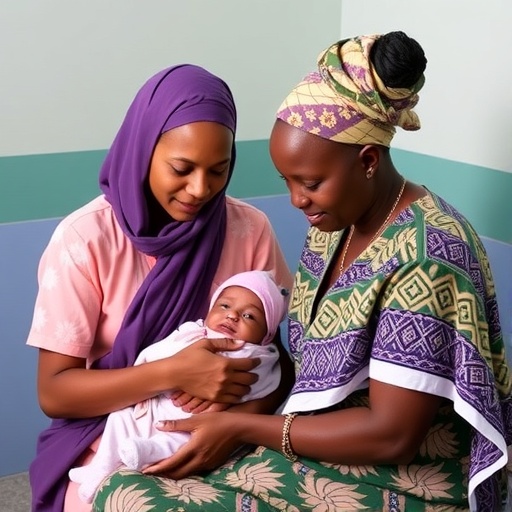In an era where the quality of healthcare delivery is paramount, the significance of effective communication among medical personnel cannot be overstated. This is particularly critical in neonatal units, where the stakes are high and every detail can impact patient outcomes. In Kenya, a remarkable study conducted by Jepkosgei et al. has initiated a transformative change in the nursing profession through the co-design and implementation of a nursing handover improvement tool tailored for newborn units.
Nursing handovers are a vital practice within healthcare settings, significantly impacting the continuity and safety of patient care. Proper handovers ensure that essential information about a patient’s condition, treatments, and preferences is accurately communicated among nursing staff. The focus of the Kenyan research was to address existing deficiencies in the handover process, particularly in the context of neonatal care where immediacy and precision are of the essence.
Through collaborative efforts that engaged frontline nurses, nursing educators, and clinical leaders, this pilot study explored various methodologies for enhancing the handover experience. By employing design thinking principles, the team was able to ascertain the barriers that current handover practices posed, allowing them to develop a tool that not only improved the procedural aspects but also fostered an environment of teamwork and mutual understanding among nurses.
The improvement tool itself is a representation of the research team’s dedication to enhancing communication within healthcare environments. It incorporates structured formats for information exchange, enabling nurses to follow a concise and thorough approach during patient handovers. This attention to detail is particularly meaningful in busy newborn units, where distractions are prevalent and time can often feel scarce.
Additionally, the training modules that accompanied the implementation of the tool were specifically crafted to provide nurses with the necessary skills to utilize it effectively. Engagement and buy-in from nursing staff were identified as crucial components of the study’s methodology. Ensuring that nurses felt a sense of ownership over the handover improvement tool contributed significantly to its successful adoption.
The results of the pilot study have been compelling, revealing positive shifts in both nurse satisfaction and patient safety metrics. Post-implementation assessments indicated that the structured handover process led to a notable reduction in communication errors, which in turn reduced the incidence of adverse events in neonatal care. Furthermore, the nurses involved reported feeling more confident and competent in their roles, valuing the consistency that the new tool provided.
Involving nurses in the co-design process proved to be transformational. It allowed for a wealth of insights to emerge directly from those who engage in handovers daily. This participatory approach not only enhanced the relevance of the improvement tool but also ensured that it was grounded in the realities and challenges faced by nursing staff in Kenyan newborn units.
Furthermore, the commitment to continuous improvement was evident as the research team established feedback mechanisms through which nurses could share their experiences and suggest modifications. This iterative process highlighted the importance of ongoing assessment and adjustment in clinical practices, emphasizing that healthcare is not static, but rather a dynamic field that evolves along with the needs of patients and healthcare providers.
The implications of such an initiative extend beyond the immediate context of Kenyan neonatal units. Indeed, the success of the co-designed nursing handover improvement tool has the potential to serve as a blueprint for other healthcare settings within low-resource environments. By demonstrating that tailored, community-driven solutions can effectively address communication gaps, this study has paved the way for similar endeavors in diverse healthcare contexts around the globe.
As the demand for high-quality neonatal care continues to grow, the insights stemming from Jepkosgei et al.’s work could influence policy-making and healthcare practices on a broader scale. The notion that frontline healthcare workers should be actively involved in shaping the tools they use is central to fostering a culture of collaboration and innovation within hospitals.
In conclusion, the co-design and implementation of the nursing handover improvement tool in Kenyan newborn units mark a significant advancement in nursing practices. The pilot study not only highlights the critical nature of effective communication within healthcare but also illustrates the power of collective action in addressing complex challenges. As healthcare systems worldwide search for improvements in patient care, the methodologies and findings from this research stand as a testament to the transformative potential of co-designed solutions.
The commitment of healthcare professionals to continual growth, improvement, and patient-centered care is what drives progress in the field. Moving forward, it is essential to not only implement these innovative strategies but also to continuously evaluate their effectiveness, ensuring that patient outcomes remain at the forefront of healthcare delivery.
Subject of Research: Nursing Handover Improvement in Neonatal Units
Article Title: Co-design and implementation of nursing handover improvement tool in Kenyan newborn units: a pilot study.
Article References:
Jepkosgei, J., Gathara, D., Mbuthia, D. et al. Co-design and implementation of nursing handover improvement tool in Kenyan newborn units: a pilot study.
BMC Nurs 24, 1329 (2025). https://doi.org/10.1186/s12912-025-03955-4
Image Credits: AI Generated
DOI: 10.1186/s12912-025-03955-4
Keywords: Nursing handover, neonatal care, communication, healthcare improvement, co-design, patient safety.




